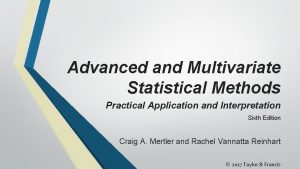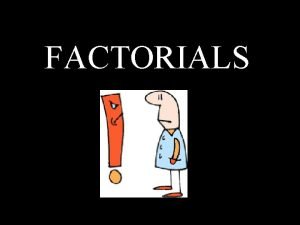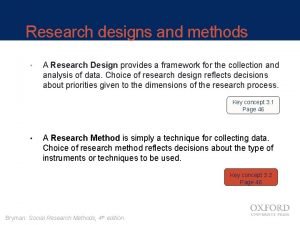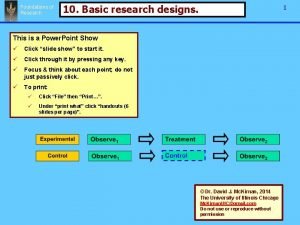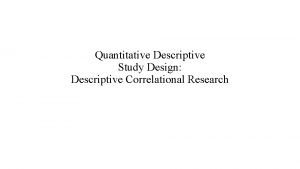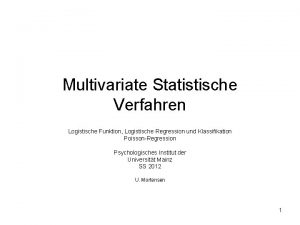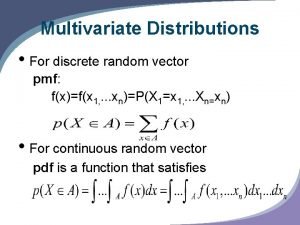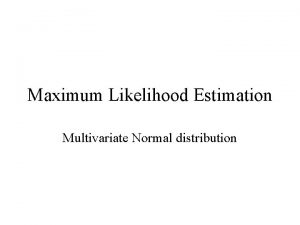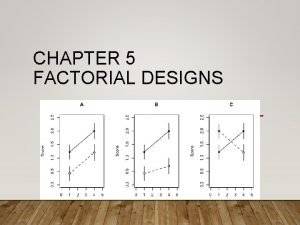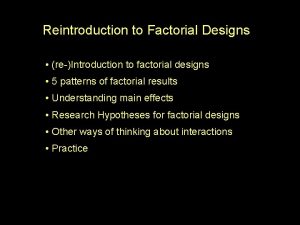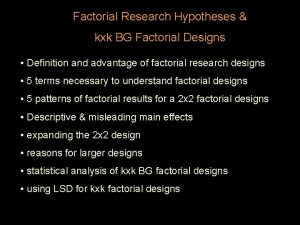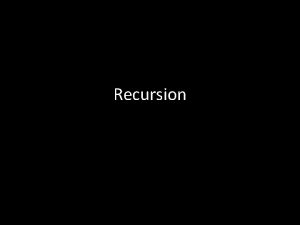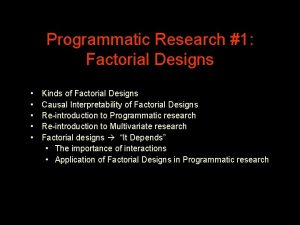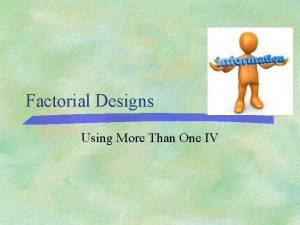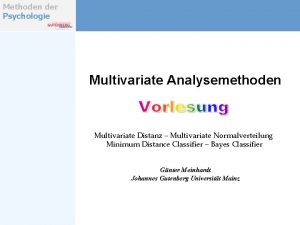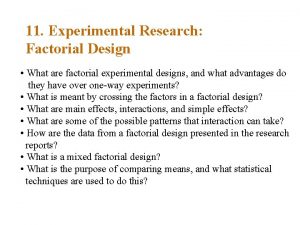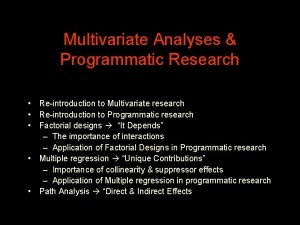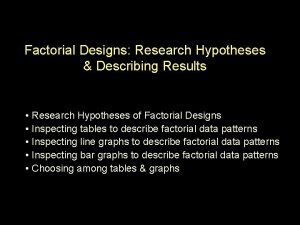Introduction to Multivariate Research Factorial Designs Definition and































- Slides: 31

Introduction to Multivariate Research & Factorial Designs • Definition and focus of multivariate research • Non-additivity & Conditionality & Interactions & Brownies • Definition and advantage of factorial research designs • 5 terms necessary to understand factorial designs • 5 patterns of factorial results for a 2 x 2 factorial designs • Descriptive & misleading main effects

Definitions and Advantages of Multivariate Research Designs Definition - a multivariate research design includes 2 or more “IVs” Why multivariate research designs? Multicausality is the idea that behavior has multiple causes, and so, can be better studied using multivariate research designs !!! (Up until now, we’ve focused on unicausality – looking at single causes of outcome variables) There are two fundamental questions about multicausality that are asked in multivariate research… 1. Interactions • does the effect of an IV upon the DV depend upon the value of a 2 nd IV? • Studied using Factorial Designs 2. Unique contributions • Is the relationship between an IV and the DV independent other IVs? • Studied using Multiple Regression

The importance of “conditional” & “non-additive” effects… Brownies – great things… worthy of serious theory & research!!! The usual brownie is made with 4 blocks of chocolate and 2 cups of sugar. Replicated research tells us that the average rating of brownies made with this recipe is about 3 on a 10 point scale. My theory? People don’t really like brownies! What they really like is fudge! So, goes my theory, making brownies more “fudge-like” will make them better liked. How to make them more fudge-like, you ask? Add more sugar & more chocolate!!!

So, we made up several batches of brownies and asked people to taste a standardized amount of brownie after rinsing their mouth with water, eating an unsalted saltine cracker and rinsing their mouth a second time. We used the same 10 -point rating scale; 1 = this is the worst plain brownie I’ve ever had, 10=this is the best plain brownie I’ve ever had. Our first study: 2 -cups of sugar 3 So, far so good! 4 -cups of sugar 5

Our second study: What? ? 4 blocks of choc. 3 8 blocks of choc. 2 Oh – yeah! Unsweetened chocolate… Then the argument started. . One side: We have partial support for theory – adding sugar helps, but adding chocolate hurts!!! Other side: We have not tested theory!!! What was our theory? Add more sugar & more chocolate!!! We need a better design!

4 blocks of choc. 2 -cups of sugar 3 4 -cups of sugar 5 8 blocks of choc. 2 What do we expect for the 4 -cup & 8 -block brownies? standard brownie 3 + sugar effect + 2 + chocolate effect - 1 expected additive effect of choc & sugar 1 expected score for 4&8 brownies 4

4 blocks of choc. 8 blocks of choc. 2 -cups of sugar 3 2 4 -cups of sugar 5 9 The effect of adding both simultaneously is 6 … not 1? ? ? How do we account for this ? There is a non-additive joint effect of chocolate and sugar!!!! The joint effect of adding chocolate and sugar is not predictable as the sum of the effects of adding each! indiidually!! Said differently, there is an interaction of chocolate and sugar that emerges when they are added simultaneously.

This leads to the distinction between two “kinds” of interactions… “Augmenting” Interaction “Interfering” Interaction # practices 10 30 ~Rew ~FB 10 15 ~Aud 10 20 FB 20 45 Aud 25 15 The combined effect is greater than would be expected as the additive effect! The combined effect is less than would be expected as the additive effect! Practice effect = 5 Feedback effect = 10 Expected additive effect = 15 Joint effect = 35 Reward effect = 10 Audience effect = 15 Expected additive effect = 25 Joint effect = 5

Introduction to factorial designs Factorial designs have 2 (or more) Independent Variables An Example… Forty clients at a local clinic volunteered to participate in a research project designed to examine the individual and combined effects of the client’s Initial Diagnosis (either general anxiety or social anxiety) and the Type of Therapy they receive (either group or individual). Twenty of the participants had been diagnosed with general anxiety and 20 had been diagnosed as having social anxiety. One-half of the clients with each diagnosis were assigned to receive group therapy and one-half received individual therapy. All clients underwent 6 months of the prescribed treatment, and then completed a battery of assessments which were combined into a DV score of “wellness from anxiety”, for which larger scores indicate better outcome. Here is a depiction of this design.

Introduction to factorial designs Factorial designs have 2 (or more) Independent Variables An Example… Forty clients at a local clinic volunteered to participate in a research project designed to examine the individual and combined effects of the client’s Initial Diagnosis (either general anxiety or social anxiety) and the Type of Therapy they receive (either group or individual). Twenty of the participants had been diagnosed with general anxiety and 20 had been diagnosed as having social anxiety. One-half of the clients with each diagnosis were assigned to receive group therapy and one-half received individual therapy. All clients underwent 6 months of the prescribed treatment, and then completed a battery of assessments which were combined into a DV score of “wellness from anxiety”, for which larger scores indicate better outcome. Here is a depiction of this design.

Showing this design is a 2 x 2 Factorial Type of Therapy Initial Diagnosis Group Individual General Anxiety clients diagnosed w/ general anxiety who received group therapy clients diagnosed w/ general anxiety who received individual therapy Social Anxiety clients diagnosed w/ social anxiety who received group therapy clients diagnosed w/ social anxiety who received individual therapy Participants in each “cell” of this design have a unique combination of IV conditions.

What’s involved in a 2 x 2 factorial design ? There are 3 variables examined … 1 -- the DV (dependent, outcome, response, measured, etc. variable) 2 -- one IV (independent, treatment, manipulated, grouping, etc. variable) 3 – second IV (independent, treatment, manipulated, grouping, etc. variable) There are 3 effects examined … 1 -- the interaction of the two IVs -- how they jointly relate to DV 2 -- the main effect of the one IV -- how it relates to the DV independently of the interaction and the other main effect 3 -- the main effect of the other IV -- how it relates to the DV independently of the interaction and the other main effect For the example… 1 -- the “interaction” of Initial Diagnosis & Type of Therapy 2 -- the “main effect” of Initial Diagnosis 3 -- the “main effect” of Type of Therapy

The difficult part of learning about factorial designs is the large set of new terms that must be acquired. Here’s a summary; ; cell means -- the mean DV score of all the folks with a particular combination of IV treatments marginal means -- the mean DV score of all the folks in a particular condition of the specified IV (aggregated across conditions of the other IV) Main effects involve the comparison of marginal means. Simple effects involve the comparison of cell means. Interactions involve the comparison of simple effects.

Identifying Cell Means and Marginal Means Type of Therapy Initial Diagnosis Group Individual General Anxiety 50 50 50 90 10 50 70 30 Social Anxiety Cell means mean DV of subjects in a design cell Marginal means average mean DV of all subjects in one condition of an IV

Identifying Main Effects -- difference between the marginal means of that IV (ignoring the other IV) Initial Diagnosis Type of Therapy Group Individual General Anxiety 50 50 50 Social Anxiety 90 10 50 70 30 Main effect of Initial Diagnosis Main effect of Type of Therapy

Identifying Simple Effects -- cell means differences between conditions of one IV for a specific level of the other IV Initial Diagnosis Type of Therapy Group Individual General Anxiety 50 50 1 Social Anxiety 90 10 2 a b Simple effects of Initial Diagnosis for each Type of Therapy a Simple effect of Initial Diagnosis for group therapy b Simple effect of Initial Diagnosis for individual therapy

Identifying Simple Effects -- cell means differences between conditions of one IV for a specific level of the other IV Initial Diagnosis Type of Therapy Group Individual General Anxiety 50 50 1 Social Anxiety 90 10 2 a b Simple effects of Type of Therapy for each Initial Diagnosis 1 Simple effect of Type of Therapy for general anxiety patients 2 Simple effect of Type of Therapy for social anxiety patients

Identifying and Describing Interactions Patterns of data that include interactions can be identified and described using the “it depends” approach. This approach is referred to different ways, here are three commonly used expressions” • the simple effect of one IV is different at different levels of the other IV • “different differences” • “different simple effects”

Here are three basic patterns of interactions #1 Task Presentation Paper Computer Task Difficulty Easy 90 = Hard 40 < 90 70 one simple effect “null” one simple effect There is an interaction of Task Presentation and Task Difficulty as they relate to performance. Easy tasks are performed equally well using paper and using the computer (90 vs. 90), however, hard tasks are performed better using the computer than using paper (70 vs. 40).

#2 Task Presentation Paper Computer Task Difficulty Easy 90 Hard 40 > < 70 simple effects are 60 opposite directions There is an interaction of Task Presentation and Task Difficulty as they relate to performance. Easy tasks are performed better using paper than using computer (90 vs. 70), whereas hard tasks are performed better using the computer than using paper (60 vs. 40).

#3 Task Presentation Paper Computer Task Difficulty Easy 80 < Hard 40 < 90 70 simple effects in the same direction, but of different sizes There is an interaction of Task Presentation and Task Difficulty as they relate to performance. Performance was better using the computer than using paper, however this effect was larger for hard tasks (70 vs. 40) than for easy tasks (90 vs. 80).

Here are the two basic patterns of NON-interactions #1 Task Presentation Paper Computer Task Difficulty Easy 30 < 50 Hard 50 < 70 both simple effects are in the same direction and are the same size There is no interaction of Task Presentation and Task Difficulty as they relate to performance. Performance is better for computer than for paper presentations (for both Easy and Hard tasks).

#2 Task Presentation Paper Computer Task Difficulty Easy 50 = 50 both simple effects Hard 70 = 70 are nulls There is no interaction of Task Presentation and Task Difficulty as they relate to performance. Performance is the same for computer and paper presentations (for both Easy and Hard tasks).

So, there are 5 basic patterns of results from a 2 x 2 Factorial Three patterns that have an interaction: = vs. < 2. < vs. > 3. < vs. < 1. one null simple effect and one simple effects in opposite directions simple effects in same direction, but different sizes Two patterns that have no interaction: < 5. = 4. vs. < = simple effects of the same size in the same direction both null simple effects

Interpreting main effects … When there is an interaction, the pattern of the interaction may influence the interpretability (generality) of the description of the marginal means. Task Presentation Paper Computer Task Difficulty Easy Hard 80 < 90 40 < 70 60 < There is a main effect for Task Presentation, overall performance was better using computer presentation than using paper presentation. 80 Notice: that the pattern of the main effect is consistent with both the simple effect of Task Presentation for easy tasks and the simple effect of Task Presentation for hard tasks.

Another example … Task Presentation Paper Computer Task Difficulty Easy 90 = 90 Hard 40 < 70 65 < 80 There is a main effect for Task Presentation, overall performance was better using computer presentation than using paper presentation. However, this pattern is descriptive for hard tasks, but not for easy tasks, for which there was no simple effect of Task Presentation.

Yet another example … Task Presentation Paper Computer Task Difficulty Easy 80 > 60 Hard 20 < 70 50 < 65 There is a main effect for Task Presentation, overall performance was better using computer presentation than using paper presentation. However, this pattern is descriptive for hard tasks, but not for easy tasks, for which performance was better using paper presentations than using computer presentation.

“Null” main effects can also be misleading…. Task Presentation Paper Computer Task Difficulty Easy 90 Hard 40 65 > < = 70 60 65 There is no main effect for Task Presentation, overall performance was equivalent using computer presentation and using paper presentation. However, this pattern is descriptive for neither hard tasks, for which computer presentations worked better than paper, nor for easy tasks, for which performance was better using paper presentations than using computer presentation.

Remember the Interaction -- simple effects of different size and/or direction No Interaction 5 1. basic patterns of results from a 2 x 2 Factorial ? = < vs. > 3. < vs. < 4. < vs. < 2. -- simple effects are null 5. or same size < vs. = one null simple effect and one simple effects in opposite directions Misleading main effects simple effects in same direction, but different sizes simple effects of the same size in the same direction both null simple effects Descriptive main effects

Factorial designs have been the fundamental design throughout the history of Psychology, because of the importance and completeness of “it depends” explanations of behavior. However, factorial designs are also among the more complex research designs we will work with this semester. The “secret” to learning these designs is to learn the language !!! cell mean marginal mean main effect simple (main) effect interaction Once you’ve mastered the terminology, the rest of it is things you are used to --- comparing means, F-values, p-values and all that. However there are several of each, and everything has its own “special” name, so again, knowing the language is key.

Prior Task Experience “none” “lots” # Practices 0 DV = putting error distance (inches) 20 30” 16” 23” 12” 4” 21” 10” 8” What sort of mean? Cell mean What population is represented? Folks with no experience who received no practice What sort of mean? Marginal mean What population is represented? Folks with lots of practice What effect involves these means? Main effect of # practices What effect involves these means? SE of Practice for those with lots of experience
 Factorial design
Factorial design Factorial research design in psychology
Factorial research design in psychology Descriptive and causal research
Descriptive and causal research Quasi experimental design example
Quasi experimental design example Multivariate analysis of variance and covariance
Multivariate analysis of variance and covariance Advanced and multivariate statistical methods
Advanced and multivariate statistical methods Definition of factorial
Definition of factorial Mixed factorial design example
Mixed factorial design example Findings of qualitative research
Findings of qualitative research Research design
Research design Basic research designs
Basic research designs Qualitative research designs chapter 10
Qualitative research designs chapter 10 Six types of qualitative research
Six types of qualitative research Action research designs
Action research designs Types of research empirical vs
Types of research empirical vs Characteristics of experimental research design
Characteristics of experimental research design Descriptive-correlational research design
Descriptive-correlational research design Analyzing and interpreting data in research
Analyzing and interpreting data in research Example of causal design
Example of causal design Distinguish between exploratory and conclusive research
Distinguish between exploratory and conclusive research Main features of qualitative research
Main features of qualitative research Methods of exploratory research design
Methods of exploratory research design Research designs
Research designs Exploratory research vs conclusive research
Exploratory research vs conclusive research Quasi-experimental research designs
Quasi-experimental research designs Quasi-experimental research designs
Quasi-experimental research designs Logistische funktion
Logistische funktion Multivariate binomial distribution
Multivariate binomial distribution Multivariate pdf
Multivariate pdf Multivariate analysis
Multivariate analysis Multiple regression assumptions spss
Multiple regression assumptions spss Likelihood function
Likelihood function





